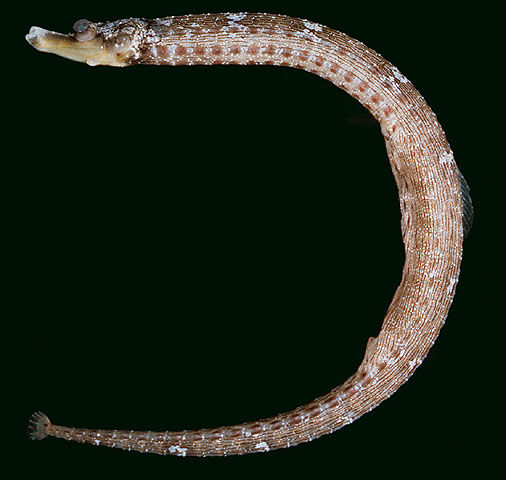Lord Howe Pipefish, Cosmocampus howensis (Whitley 1948)

The Lord Howe Pipefish, Cosmocampus howensis. Source: John E. Randall. License: CC BY Attribution-Noncommercial
A blotchy brown pipefish sometimes with darker speckling and indistinct pale bars. The Lord Howe Pipefish inhabits subtropical to temperate reefs in the south Pacific.
Lord Howe Pipefish, Cosmocampus howensis (Whitley 1948)
More Info
|
Distribution |
Lord Howe Island and Middleton Reef in the Tasman Sea, and from Southport in southern Queensland to Jervis Bay, New South Wales. Elsewhere, the species occurs in subtropical and temperate waters of the southwest-central Pacific (Kermadec Islands, New Zealand to Easter Island). Inhabits inshore reefs. |
|
Features |
Dorsal fin 27-30; Pectoral fin 13-16; Trunk rings 15-17; Tail rings 33-36. Head length 8.1-9.6 in SL, snout depth 2.3-3.5 in snout length. Superior trunk and tail ridges discontinuous; lateral trunk ridge straight, ends near anal ring; median dorsal snout ridge entire to partly emarginate; lateral snout ridge usually present; short snout, snout length 2.1-2.6 in HL; dermal flaps usually present on eye and elsewhere on head; opercular keel reduced to anterior half of operculum. |
|
Size |
Maximum length about 120 mm. |
|
Colour |
Pale coloured; head plain or heavily blotched with dark brown; dorsal surface of body sometimes with indications of 10-11 diffuse pale bars; body otherwise with numerous dark streaks and spots; dorsal and pectoral fins sometimes shaded with brown. |
|
Feeding |
Unknown, but likely to feed on small crustaceans. |
|
Biology |
The eggs are brooded by the males in a pouch on the underside of the body behind the anus. The pouch protects the dorsal surface and side of the egg mass, leaving the ventral surface exposed. Males may begin brooding at 72 mm TL. The eggs are undescribed, but deposited in 2-17 transverse rows within a gelatinous matrix. Larvae: Undescribed. |
|
Fisheries |
Of no interest to fisheries or aquaculture. |
|
Conservation |
Australian Commonwealth Legislation: Marine listed under the Environment Protection and Biodiversity Conservation Act, 1999 (EPBC Act) State Legislation: Protected under the New South Wales Fisheries Management Act. |
|
Remarks |
|
|
Etymology |
Cosmocampus is from the Greek, kosmos meaning order or organization, and kampos meaning sea-animal. The species name howensis, is after the type locality, Lord Howe Island. |
|
Species Citation |
Parasyngnathus howensis Whitley 1948, Rec. Aust. Mus. 22(1): 77, Lord Howe Island. |
|
Author |
Vanessa J. Thompson & Dianne J. Bray |
Lord Howe Pipefish, Cosmocampus howensis (Whitley 1948)
References
Allen, G.R., D.F. Hoese, J.R. Paxton, J.R. Randall, B.C. Russell, W.A. Starck II, F.H. Talbot & G.P. Whitley. 1976. Annotated checklist of the fishes of Lord Howe Island. Rec. Aust. Mus. 30(15): 366 454.
Dawson, C.E. 1985. Indo-Pacific Pipefishes (Red Sea to the Americas). Gulf Coast Research Laboratory, Ocean Springs, Mississippi. 230 pp.
Francis, M.P. 1993. Checklist of the coastal fishes of Lord Howe, Norfolk, and Kermadec Island, southwest Pacific Ocean. Pacific Science 47(2): 136-170.
Herald, E.S. & J.E. Randall. 1972. Five new Indo-Pacific pipefishes. Proc. Calif. Acad. Sci. 39(11): 121-140.
Johnson, J.W. 1999. Annotated checklist of the fishes of Moreton Bay, Queensland, Australia. Mem. Queensland Mus. 43(2): 709-762.
Kuiter, R.H. 2009. Seahorses and their relatives. Aquatic Photographics, Seaford, Australia.
Paulus, T. 1999. Family Syngnathidae. In Carpenter, K.E. & V.E. Niem. 1999. Species identification guide for fisheries purposes. The living marine resources of the western central Pacific. Bony fishes part 2 (Mugilidae to Carangidae). FAO, Rome.
Paxton, J.R., J.E. Gates, D.F. Hoese & D.J. Bray. 2006. Syngnathidae, pp. 810-846. In Beesley, P.L. & A. Wells (eds). Zoological catalogue of Australia. Volume 35. ABRS & CSIRO Publishing, Australia. 2178 pp.
Pogonoski, J.J., D.A. Pollard & J.R. Paxton. 2002. Conservation Overview and Action Plan for Australian Threatened and Potentially Threatened Marine and Estuarine Fishes. Environment Australia, Canberra. 375 pp.
Randall, J.E. 1999. Report on fish collections from the Pitcairn Islands. Report on fish collections from the Pitcairn Islands. Atoll Res. Bull. 461: 1-36 + 14 unnumbered pp (figs.)
Stewart, A.L. 2015. 148 Family Syngnathidae (p. 1050-1062) in The Fishes of New Zealand. Volume 3: 577-1152.
Whitley, G.P. 1948. Studies in Ichthyology No. 13. Rec. Aust. Mus. 22(1): 70-94.


